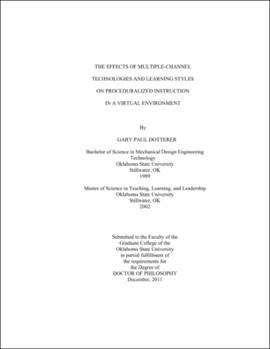| dc.contributor.advisor | Ausburn, Lynna | |
| dc.contributor.author | Dotterer, Gary Paul | |
| dc.date.accessioned | 2013-11-26T08:34:23Z | |
| dc.date.available | 2013-11-26T08:34:23Z | |
| dc.date.issued | 2011-12 | |
| dc.identifier.uri | https://hdl.handle.net/11244/7373 | |
| dc.description.abstract | Scope and Method of Study: No research has examined the effects on performance outcomes when learning style preferences and multiple-channel interactive media integrated with assistive technologies are delivered through an online virtual learning environment (VLE). When innovative multichannel technologies are introduced in online virtual environments to deliver instructional content, this media-rich content may not be accessible for all learners unless assistive technologies can be successfully included. As online VLEs increase in popularity and are able to handle sophisticated and complex media, the lack of effectiveness data and the ability to support multi-channel assistive technology devices are problematic. This quasiexperimental study examined the effects on performance outcomes when the cognitive portion of the cardiopulmonary resuscitation certification process were delivered using three multiple-channel treatments with assistive technologies through an online VLE. A purposive sample of 284 CareerTech technology center and two-year associate degree trade community college students were administered the VARK (visual, aural, read/write, kinesthetic) learning styles survey and were then randomly assigned to one of three multi-channel treatments followed by a CPR cognitive post-test. Post-test data were analyzed with 2-way factorial ANOVA. | |
| dc.description.abstract | Findings and Conclusions: No main effects for treatment or for VARK learning style, or interaction of these two factors, were found. Based on these findings plus those from a pilot study and literature review, several conclusions were drawn, including: | |
| dc.description.abstract | 1. Learning style as defined by VARK (i.e., related to preferred stimulus input modality) is not a contributor to performance in an online VLE using multichannel assistive technologies. This supports a growing literature contention that learning styles may not be as important as many believe. Further, these styles do not appear to interact with specific combinations of media. | |
| dc.description.abstract | 2. Many combinations of multi-channel media can contribute equally well to learning. This supports the effectiveness of assistive technologies in VLEs to provide access for all learners. It also suggests that instructional design may be more important for learning than specific combinations of media. | |
| dc.format | application/pdf | |
| dc.language | en_US | |
| dc.rights | Copyright is held by the author who has granted the Oklahoma State University Library the non-exclusive right to share this material in its institutional repository. Contact Digital Library Services at lib-dls@okstate.edu or 405-744-9161 for the permission policy on the use, reproduction or distribution of this material. | |
| dc.title | Effects of multiple-channel technologies and learning styles on proceduralized instruction in a virtual environment | |
| dc.contributor.committeeMember | McCharen, Belinda | |
| dc.contributor.committeeMember | Song, Ji Hoon | |
| dc.contributor.committeeMember | Ausburn, Floyd | |
| dc.contributor.committeeMember | Antonenko, Pasha | |
| osu.filename | Dotterer_okstate_0664D_11745.pdf | |
| osu.accesstype | Open Access | |
| dc.type.genre | Dissertation | |
| dc.type.material | Text | |
| thesis.degree.discipline | Education | |
| thesis.degree.grantor | Oklahoma State University | |
